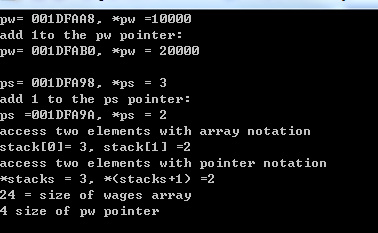C++ Primer Plus 第6版
指针和数组基本等价的原因在于指针算术!
一、指针
⑴整数变量+1后,其值将增加1;
⑵指针变量+1后,增加的量等于它指向的类型的字节数;
⑶C++将数组名解析为地址;
例如:如果系统对double使用8个字节存储,其数值将增加8,
如果系统对short使用2个字节存储,则指针值将增加2
#include <iostream> int main() { using namespace std; double wages[3]={10000.0,20000.0,30000.0}; short stacks[3]={3,2,1}; double *pw=wages; // 将 pw 声明为指向 double类型的指针,然后将它初始化为wages----wages数组中的第一个元素的地址
short *ps=&stacks[0]; int a;//-----仅为保持dos界面 cout<<"pw= "<<pw<<", *pw ="<<*pw<<endl; pw=pw+1; cout<<"add 1to the pw pointer: "; cout<<"pw= "<<pw<<", *pw = "<<*pw<<" "; cout<<"ps= "<<ps<<", *ps = "<<*ps<<endl; ps=ps+1; //指针+1 等价于 *(stacks+1) cout<<"add 1 to the ps pointer: "; cout<<"ps ="<<ps<<", *ps = "<<*ps<<endl; cout<<"access two elements with array notation "; cout<<"stack[0]= "<<stacks[0] <<", stack[1] ="<<stacks[1]<<endl; cout<<"access two elements with pointer notation "; cout<<"*stacks = "<<*stacks <<", *(stacks+1) ="<<*(stacks+1)<<endl; cout<<sizeof(wages)<<" = size of wages array "; cout<<sizeof(pw)<<" size of pw pointer "; cin>>a;//-----仅为保持dos界面
return 0;
}

解释上述代码:
1、在多数情况下,C++将数组名解释为数组第一个元素的地址;
和所有数组一样wages也存在下面的等式:
wages = &wages[0] =address of first element of array
除了首地址可以这么简写,其他的都必须为 “&+变量名+索引[]”
2、stacks[1] 和 *(stacks +1) 是等价的:可以这么理解,stacks是数组名的第一个元素地址,stacks=&stacks[0]--->(stacks+1)=&stacks[0+1]
所以 *(stacks +1) 等价于 stacks[1]
*(stacks +2) 等价于 stacks[2]
结论:
① 使用数组表示法时:
arrayname[i](数组名) 等价于 *( arrayname + i )
② 使用指针表示法时:
pointername[i](指针名称) 等价于 *( pointername + i)
③2者使用时区别
pointername=pointername+1; //正确的
arrayname=arrayname+1; //不正确的
下面这个例子是:地址偏移,和地址对应的数值
double wages[3]={10000.0,20000.0,30000.0}; double *pw=wages; double *pw1=&wages[1]; cout<<"pw= "<<pw<<", *pw ="<<*pw<<endl; cout<<"pw= "<<pw1<<", *pw ="<<*pw1<<endl; pw=pw+1; cout<<"add 1to the pw pointer: "; cout<<"pw= "<<pw<<", *pw = "<<*pw<<" ";

二、数组
1、静态联编(静态数组)
使用数组声明来创建数组时,将采用静态联编,即数组的长度在编译时设置:
int tacos[10];//static binding,size fixed at complie time
2、动态联编(动态数组)
使用 new[]来创建数组时,将采用动态联编(动态数组),即将在运行时维数组分配空间,其长度也将在运行时设置。使用完这种数组后,应使用delete[]来释放其占用的内存:
int size; cin>>size; int * pz=new int [size]; //dynamic binding,size set at run time ... delete [] pz; //free memony when finished
三、指针算术
C++允许将指针和整数相加。加1的结果等于原来的地址值加上指向的对象占用的总字节数。
仅当2个指针指向同一个数组时,这种运算才有意义:这将得到2各元素的间隔。
int tacos[10]={5,2,8,4,1,2,2,4,6,8}; int * pt =tacos; pt= pt + 1; int * pe=&tacos[9]; pe=pe - 1; int diff=pe-pt; // 结果:7